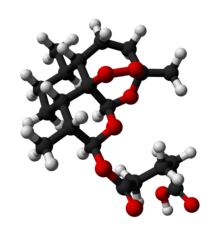Artesunate
 |
|
 |
|
| Clinical data | |
|---|---|
| Pronunciation | ahr-tez′ŭ-nāt |
| Trade names | many |
| AHFS/Drugs.com | International Drug Names |
| Routes of administration |
by mouth, intravenous, intramuscular |
| ATC code | P01BE03 (WHO) |
| Legal status | |
| Legal status |
|
| Identifiers | |
| CAS Number |
88495-63-0 80155-81-3 (sodium salt) |
| PubChem (CID) | 5464098 |
| ChemSpider |
16735675 |
| UNII |
60W3249T9M |
| ChEMBL |
CHEMBL258608 |
| NIAID ChemDB | 112081 |
| ECHA InfoCard | 100.106.898 |
| Chemical and physical data | |
| Formula | C19H28O8 |
| Molar mass | 384.421 g/mol |
| 3D model (Jmol) | Interactive image |
|
|
|
|
|
|
|
Artesunate (AS) is a medication used to treat malaria. The intravenous form is preferred to quinidine for severe malaria. Often it is used as part of combination therapy. It is not used for the prevention of malaria. Artesunate can be given by injection into a vein, injection into a muscle, or taken by mouth.
Artesunate is generally well tolerated. Side effects may include a slow heartbeat, allergic reaction, dizziness, and low white blood cell levels. During pregnancy it appears to be a safer option, even though animal studies have found harm to the baby. Use is likely okay during breastfeeding. It is in the artemisinin class of medication.
Artesunate is on the World Health Organization's List of Essential Medicines, the most effective and safe medicines needed in a health system. The wholesale cost in the developing world is 2.09 to 2.57 USD a dose. It is not commercially available in the United States; however, can be gotten from the Centers for Disease Control. It was originally made from the sweet wormwood plant.
Artesunate is the first line treatment for children or adults with severe malaria. The recommendation is to treat with at least 24 hours of artesunate by injection. Artemisinin-based combination therapy may be used by mouth in persons that can tolerate it after 24 hours by injection. In facilities where long-term care is not appropriate, artesunate may be given as a single intramuscular injection or by rectal route (children < 6 years) prior to transferring care to a higher level facility.
...
Wikipedia
